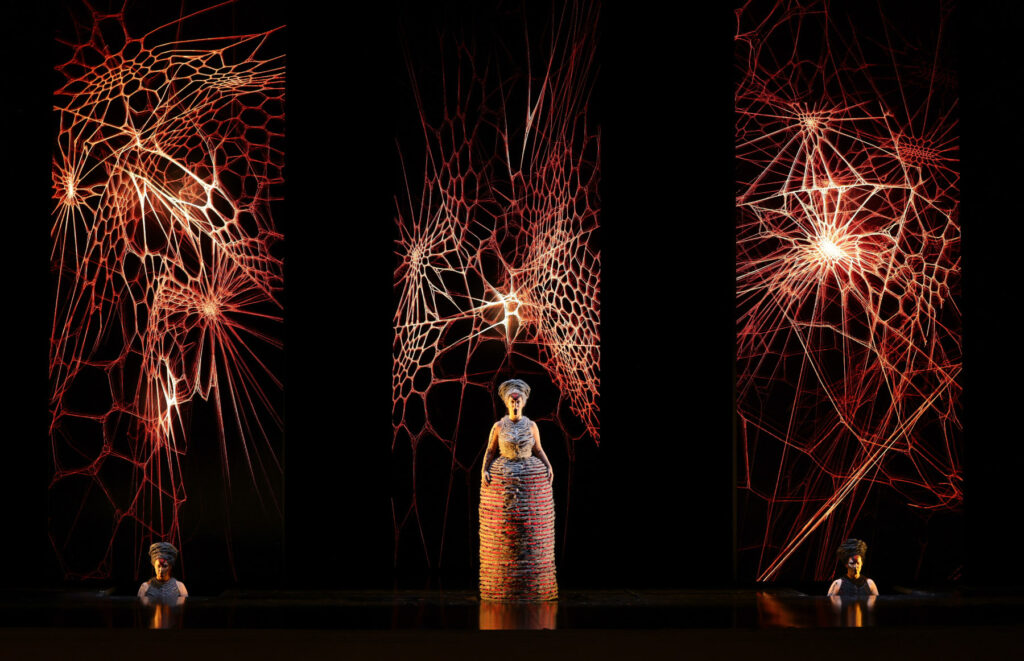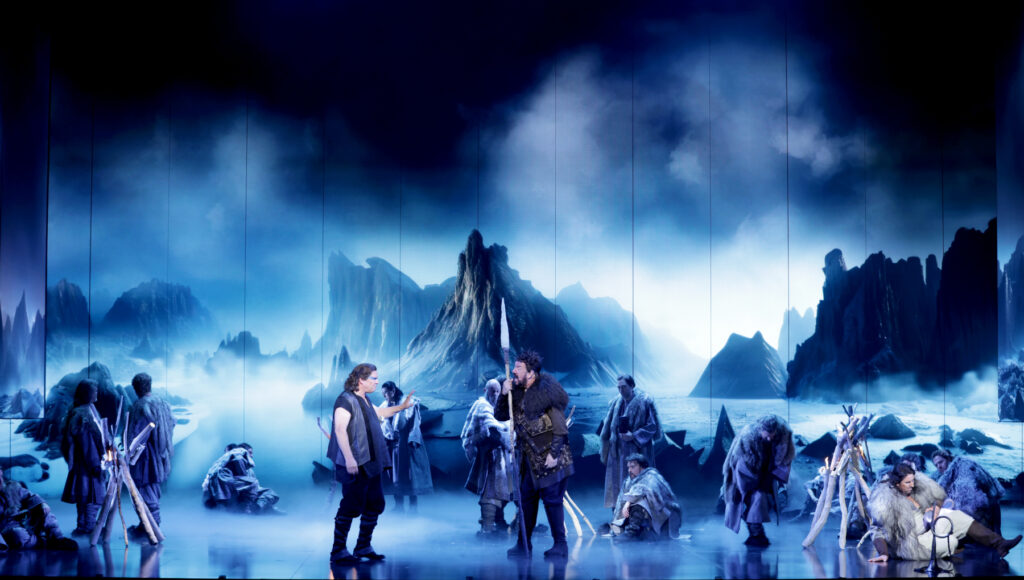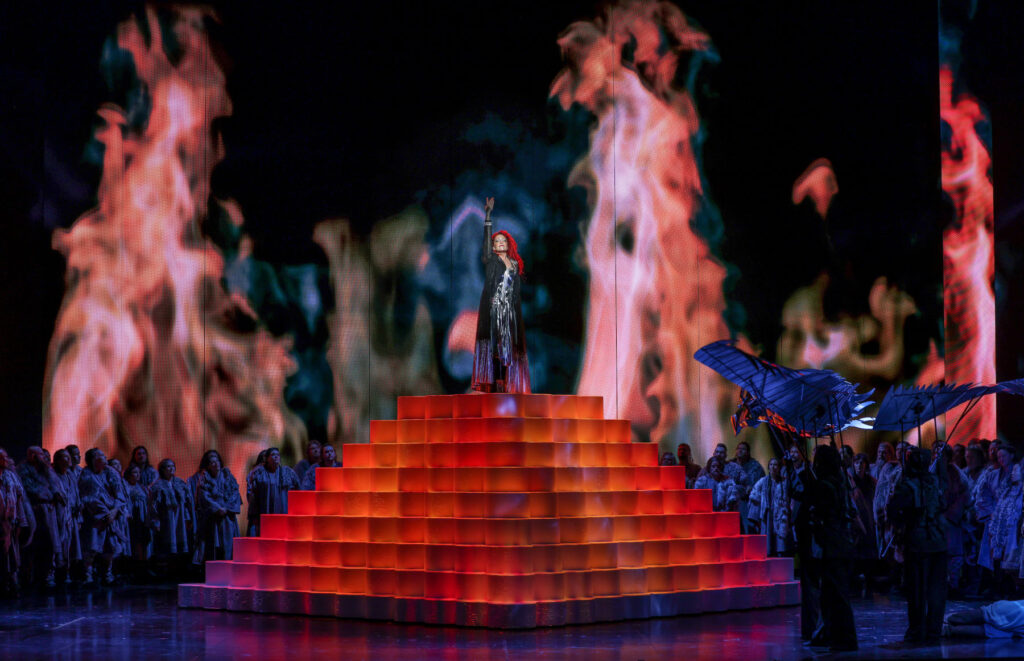In one small but powerful and sobering moment, with micro-second flashbacks of digital imagery taking the audience back to where it all began seven days previously, it rather felt like coming out of and simultaneously being sucked into a black hole at the conclusion of Götterdämmerung and Opera Australia’s wondrous new Ring cycle. Director and designer Chen Shi-Zheng had taken us on a fantastical, inquiring and enlightening journey befitting Wagner’s otherworldly, mythological saga. Across more than 15 hours of music drama, its sprawling cast had brought vivid and affecting life to their characters, conductor Philippe Auguin dictated the spectrum of moods with often breathtaking effect and the Queensland Symphony Orchestra can now add a huge feather to their bow. In fact, it’s a remarkable triumph for the hundreds involved both on and behind the scenes.
In a sense, if Götterdämmerung was all we knew, the breadth and gist of The Ring’s story could still be conveyed. As in previous installments, Wagner constantly weaves references to events past and foreseen through the present so the audience is never lost — you see exactly how events develop and where they end. With just over four and a half hours of music drama, it’s the longest installment but a doddle to sit through and awe-inspiringly multi-climactic. For those intrigued and contemplating splashing out and diving into Wagner’s Ring to test its waters, this is the one.
It begins with the three Norns giving an update on a few details and weaving their rope of Fate. Not only do the statuesque trio Celeste Haworth, Angela Hogan and Olivia Cranwell share their ruminations with inviting vocal chiaroscuro but Anita Yavich’s gowns, designed as huge reels of twine, add to her cleverly creative collection. Together with Leigh Sachwitz and her team at Berlin-based flora&faunavisions’s restrained use of digital imagery — spatially shifting and thread-like forming webs on screens behind each Norn — it’s an evocative and tasteful opening scene.

Into a new corner of time, Wagner takes us inside the castle of the Gibichungs where the ruler Gunther, his sister Gutrune and half-brother Hagen (Alberich’s son), welcome Siegfried to their domain and plot to obtain the ring. Sachwitz rewards the eye with a monumental digital setting, possibly reminding others of Fritz Lang’s influential 1927 German expressionist science-fiction silent film, Metropolis and giving the cycle its most striking, architecturally representative digital effect. It is further made memorable by Yavich’s costumes of animal skins and thick woollens, ancient Siberian/Central Asian in character, and a model of an ice-city on an ice-cut table.
Of course, the audience, primed for the unexpected, realizes by now that Sachwitz’s imagery rarely remains static. When Siegfried takes the drink offered by Gutrune that makes him forget his bride Brünnhilde, veils of fluorescent magenta waft across the cavernous digital chamber matching the potion’s color as Siegfried becomes dizzy. All but a solo beam of rotating light is all that greets Brünnhilde’s traumatized entry with Gunther as he leads his bride through the chorus of vassals. And later, Siegfried is murdered by Hagen on a barren ice field as Wotan’s planet-like eye watches on in a composition of foreboding surrealism. The subsequent desolation and austerity accompanying the achingly emotive music of Siegfried’s Funeral March, as a team of bearers drag a sled through the harsh conditions to collect his body, does poignantly wrought justice in edifying the cycle’s most tragic moment.
So on and so on, until the great Immolation Scene when Brünnhilde orders a funeral pyre to be built after removing the ring from Siegfried’s finger. Brünnhilde climbs to the top of a stepped pyramidal centerpiece and Grane glides in, her docile puppeteer-led three-part Phoenix — mind you, its central incomplete body started reminding me of a cut-off prawn head. An explosive digital calamity of fire and water begins, as if emanating from a vortex of energy within the ring itself whose image is prominently high at the rear. Following rapidly, in the torrent of the Rhine, trapeze artist Rhinemaiden doubles dive down, the ring is snatched from Brünnhilde and those aforementioned flashbacks take us to the cycle’s starting point.

As final heroine of the epic, manipulated to the point of becoming complicit in Siegfried’s demise, Lise Lindstrom soars in a passionate, radiant, and sumptuous voice, giving consistently believable naturalness to her anguished rollercoaster ride. For her entire duration on stage from her first gung-ho arrival in Die Walküre, Lindstrom delivered the goods in transcendent form.
Question marks soon melted away after a starting loss of shape in his upper range before Stefan Vinke went on to calibrate his hefty and blustery instrument with superhuman power across Siegfried’s similarly deceived final days. Kindling endearment and sympathy with his audience, even so when his pleased-as-punch Siegfried revels in the arms of Gutrune in Brünnhilde’s presence, Vinke gives his all in a performance that cuts to the heart.
A phenomenal presence both physically and vocally and in a stroke of casting genius, it is as if all three of Andrea Silvestrelli’s previous performances as Fafner the giant, Hunding and Fafner the dragon are melded into his beastly, dark-minded Hagen. Luke Gabbedy makes a solid mark as the ill-fated Gunther and the rich and dynamic-voiced Maja Kovalevska is sterling as the whirlwind of circumstances engulf Gutrune.
Although not enough to sway Brünnhilde, Deborah Humble bejewels Waltraute’s visit to her sister to plead the ring’s return to the Rhinemaidens with exhilarating force. And into the history books Warwick Fyfe goes in accomplishing a feat of operatic strength and flexibility after demonstrating what a commanding Wotan he can portray in Melbourne Opera’s Bendigo Ring earlier this year and following up with a performance equal to the world’s best with his persistently parasitic and impactful Alberich.

For the first time in the cycle, a heaving chorus of voices from the ranks of Opera Australia and Opera Queensland combined for a thrilling appearance and, maneuvering the entire juggernaut, Auguin is to be lauded for bringing pronounced sensitivity amongst the troughs and peaks of Wagner’s intoxicating leitmotif-studded score.
When it all began with Das Rheingold, seemingly eons ago, it was somewhat perplexing as to what Chen was aiming to achieve with his digital world backgrounded and enveloped around the saga. On the other hand, what became quickly apparent and remained constant throughout was that Chen’s storytelling would honor Wagner’s narrative comfortingly, matching it with legibly interpreted elements instrumental to the story’s progression.
Chen’s concept of “modern science fiction” is not one that entertains the potentiality of human endeavor, failures, achievements and social makeup. All along it is simply and commendably pure fantasy, a dreamy universe eliciting myriad associations to time, place and culture. Within it, living beings, despite having proven their ability to cause or adapt to external change, operate on life governed by the good and bad — the light and dark — of entrenched individual and collective psychologies and actions unrelated to time.
More and more as the cycle continued, the depth and effect of the digital content worked its way into reflecting or creating a dialogue with the force of the drama’s stage direction. That its intent was to freely represent the architectural and environmental or associate the psychological or metaphorical became evident, although not always clear. Nevertheless, there is the possibility to tweak this digital world ever so gently to give this Ring an exciting life ahead.
In the end, a major part of experiencing the beauty of The Ring’s vast, fluid timeline and the territory it covers, together with its ordained and restless themes, is to waft away on momentary and personally rewarding thoughts that art of such magnitude can offer. Chen feeds that potential in providing that gloriously human channel without allowing a single moment for thoughts to stray to the shopping list. You’re more likely to want another week of it.
Paul Selar
Top Image: Maija Kovalevska as Gutrune, Luke Gabbedy as Gunther, Stefan Vinke as Siegfried and the Opera Australia Chorus
Photo Credit: Wallis Media